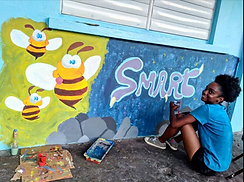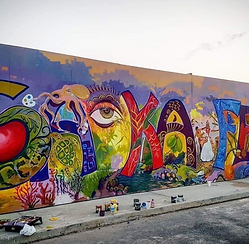Arts & Cultural Response
The arts and culture scene can always provide a unique insight on to how communities respond to the trauma of natural disasters and the frustrations surrounding the progress forward in the aftermath. Dominica is home to a unique eclectic range of art, some art originating right from Dominica’s soil, with all artists add their own creole flavor. Lennox Honychurch in his book The Dominica Story: A History of the Island goes into depth on how Dominica's cultural landscape evolved from African and European traditions.
Investing in the arts and cultural landscape is vital in Dominica’s push for climate resilience since resilience also requires communities that can work together and understand one another with one goal. It is important to never underestimate the power that art possesses in speaking for communities that are invisible to most and in making people feel seen and heard.

J'Ouvert Morning Carnival Monday 2023 shot by Daniella Rolle
Carnival
Photos from the Opening of Carnival 2023 shot by Daniella Rolle
One of the most vibrant and historical displays of music and fashion culture is the carnival season. The culture of carnival was forged through the fire of colonialism and exploitive slavery. A culture was born on the slave plantations — one that was a mosaic of African and French culture.
Traditonal Sensei Costume
In Roman Catholic traditions in Europe, two days of feasting occurs before lent. The French would celebrate Samedi Gras through J’Ouvert to Mardi Gras. This tradition was brought to the Caribbean by the French settlers. These were days when the French estate families would visit each other for creole fetes (parties). The slaves would dance outside while others played music indoors, served, and entertained for tips. Since the emancipation, the former slaves brought the festival to the streets on the weekend before lent. Masquerade, which would become carnival, became a brief annual revolt of the masses of society. Many of the costumes used were taken from those used in tribal festivals in Central African Kingdoms, such as those for the sensei.

Jou'vert Morning

Dominican Carnival has always been a time to reflect on the community’s resilience from the days of slavery and historically given space for the forcefully displaced people to connect themselves to their homelands. In Dominica carnival is not only a celebration for those who are descendants of slaves, but it also has made room for the Kalinago people’s expression of their culture and for any other people group on the island are given an open invitation to participate. Dominica’s carnival is a special one. It brands itself as the most original carnival because it still retains vibrant displays of African traditions through the music and costumes in comparison to the more modernized/westernized version of carnival practiced on other islands.
Currently, Carnival is no longer just a two-day celebration, but fitting to the Caribbean attitude, it now encompasses an entire month long celebration with events displaying the arts and culture of the island every day. One of the key elements of carnival is calypso music. Google Arts & Culture describes calypso as an Afro-Caribbean musical tradition that emerged in Trinidad and Tobago in the mid-19th century. Its roots are believed to stem from the West African Kaiso and Canboulay music sung by African slaves working on plantations in the 17th century. The music became a means of communication when “Enslaved Africans were not allowed to communicate with each other” (Google Arts & Culture). From its origins, in the Caribbean it emerged featuring various elements of Trinbagonian culture. The history of calypso functions as a catalog of the process and sentiments felt by communities in the Caribbean for the struggle towards freedom under different time periods. The lyrics are raw expressions of politically-charged statements that are disguised by the charismatic and easy-going poetic ballads and rhythms. It is a genre that requires an attentive ear.
The month of February in Dominica is full of calypso tents across the island with local artists singing humorous and insightful social commentaries. Cleverly crafted lyrics allow for individuals to express injustices and struggles that entire communities face. Calypso is a medium allowing citizens to hold their political leaders accountable for gaps in governance and empty promises. In 2023 calypsonians sang about the themes of government corruption, inflation crisis, and gas shortages.
All Videos
All Videos


Trilla-G - "DICK TAYLOR SHIP" (Calypso 2023) Lyric Video

Daddy Chess Hegas No Gas Dominica Calypso 2023

Mighty D - Talking Dogs

Shanice - #CONCERNED -Dominica Calypso 2023
Carnival is more than just a party; it provides room for reflection of where Dominican people have been and gives hope to many for the future. Rain or shine, corrupted governance or oppression will not stop people from gathering in the streets to celebrate their culture and roots. Calypso and carnival remain a crucial part of Dominica’s ability to practice community-based resilience, regardless of the challenges ahead. Carnival is a time to remember where Dominicans have come from and when they have fought and progressed. It continues to be an emblem to fight for a safer and better future. Maintaining and investing in calypso music and carnival festivities must continue to grow for the country to maintain a tight-knit community.
Waitukubuli Art Association
Images from @kubuliarts Instagram
Paul Crask, a travel guide, wrote a piece on the formation of the Waitukubuli Art Association (WAA) in 2022 that helped give insight on the ways the association has enhanced Dominica's artistic scene. The WAA was formed just before Hurricane Maria and became a pillar of Dominica's cultural landscape in the aftermath. The association consists of a collection of young local artists who used art to reflect on Maria's devastation and hope for future resilience in the WhoOsh exhibit. Art played a vital role in giving outsiders a visual understanding of the devastation Hurricane Maria caused and the raw emotions many of the island's residents felt. The Organization of Eastern Caribbean States (OECS) hosted a virtual photography exhibit titled "Climate Change: An Eastern Caribbean Journey." The exhibition displays the work of artists from Dominica and nearby islands which all center around climate change. Dominican artists featured focused on the wounding effects of Maria and Erika through photography and video messages from the artists about their work.
To walk through the OECS virtual exhibit follow this link

"Looking Back" by Yuri. A Jones

"In Despair" by Yuri A. Jones

Beyond the story of devastation, the art association has grown and gives artists an opportunity to share Dominica’s culture and stories of individuals through the powerful mediums of art. In the aftermath of Maria, artists painted murals around the island beautifying landscapes and depicting messages of hope.
Images from @kubuliarts on Instagram


I had the recent privilege of attending one of their exhibits and saw pieces reflecting on community structures, Dominican cultural elements, and national pride. The renaissance of Dominican art is bringing more people from different age groups together in the city providing an important social connection scene for locals and tourists.
CREAD has also recognized the importance of using art as a means of communicating messages to the people in creative ways. To ensure that 90% of the population can identify the pillars of resilience, CREAD in partnership with the Waitukubuli Art Association coordinated with artists on the island to paint murals that represent the artists' interpretation of the pillar they are assigned.
From CREAD website

Ray Francis
Aaron Hamilton
Hilroy Fingal
The mural campaign encourages the population to engage with the pillars from all over the island. Each of the murals has a QR code that citizens and tourists can scan to learn more about the pillar.

















